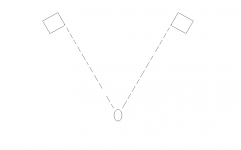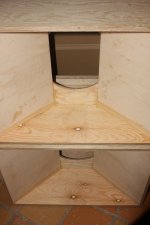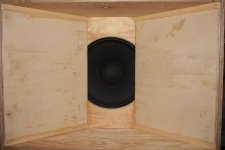Markus,
Just posted some thoughts about such a design here: http://www.diyaudio.com/forums/mult...ns-beaten-behringer-what-140.html#post3399569
Just posted some thoughts about such a design here: http://www.diyaudio.com/forums/mult...ns-beaten-behringer-what-140.html#post3399569
As noted already, the wall reflection can be avoided in the freq range causing problems by using a large radiating surface for midrange. At high freqs can use a horn.
I can see only benefits of using on wall speaker. Only problem I can come up with is not all the rooms have available walls to place speakers, but often there are doors, passage ways, fire places, etc.
I also think the reason why there is practically no commercial wall placement speakers is exactly the requirement for large ratiating surface. All hifi speakers use tiny (5"-8") speaker elements, but here we would like to use 12" or bigger. Generally people are not used to that idea.
- Elias
I can see only benefits of using on wall speaker. Only problem I can come up with is not all the rooms have available walls to place speakers, but often there are doors, passage ways, fire places, etc.
I also think the reason why there is practically no commercial wall placement speakers is exactly the requirement for large ratiating surface. All hifi speakers use tiny (5"-8") speaker elements, but here we would like to use 12" or bigger. Generally people are not used to that idea.
- Elias
I think so. As the primary motive behind them is to keep the sound off the nearby walls until it's been out in the room long enough not to matter, it's important that they aren't wasted by pointing them where they illuminate a wall. Most people choose to have them pointing out of a corner, also pulled out from the corner and crossing in front of the listener.I'm willing to sacrifice pinpoint accuracy to some degree but waveguides seem to get the job done well enough without sacrificing too much.
Furthermore the lack of reflections does, in my opinion, improve imaging accuracy although pinpoint isn't a word I'd use because it reminds me of the days when I needed to hold my neck still while listening to the really good bits. Good imaging makes you almost able to 'see' the performers' location and there shouldn't need to be any 'zeroing in on it'.
Good imaging makes you almost able to 'see' the performers' location...
not only almost, but actually does it, and very accurately too
it only depends on the source material
but there is a hatch
when you get used to it, anything else sounds wrong
OT tinitus, did you decide to build your speakers with the two-way waveguides?
how long ago was this ?
but yes, even if now different, it may still end that way
learned my lesson, and this time I built a pair, just in case...

Attachments
Up against the wall of science
In commercial sound some of our Synergy horns are mounted on boundaries because that eliminates the reflections from that entire plane.
While usually that is the ceiling or floor boundary, I have tried it in the home setting with walls and it works remarkably well .
The elimination of the reflections is possible because some of the loudspeakers are acoustically array-able, not just fit side by side physically. It’s funny, there are extremely few commercial loudspeakers which even though “array able”, do not join together into an inaudible seam while these do. When two of these are arrayed, you cannot hear a seam or the normal comb filtering one normally gets with two or more sources.
How?
They radiate the entire frequency range “as if” they had a single driver located at the very rear of the enclosure and so what emerges at the mouth is a large radius wave front and from a horn exit large enough to have pattern control to a fairly low frequency (very low in hifi speaker terms).
The horn also has the same wall angle as the cabinet wall angle and typically the horn is only a couple inches inside of the outer cabinet wall (making the acoustic separation small compared to where the horn pattern control is lost, thus, they act like one source)
The result is something like the graphic fig1 at the bottom of this page;
http://www.danleysoundlabs.com/danley/wp-content/uploads/2012/01/The-Tapped-Horn.pdf
Now, here one has a acoustic mirror image with the two speakers side by side. “IF” one takes one of the arrayable sides and puts it on the ceiling, floor or walls, one has a physical acoustic mirror image.
If you picture a wall boundary in place of the second cabinet (angled cabinet side against the wall), one has an analogous condition to a pair of sources. Take a TEF measurement of one on the floor like that and all you see is a lift in the low end below about 300hz. Because of the directivity and horn wall angles, standing in front of a pair, you are never in the pattern of both unless your exactly at the center and then, the sources are only a few inches apart and form an inaudible seam.
You can see from the measured polar plots of two that they do not interfere with each other and even down to 500Hz, the sound radiated to the rear and 90 degrees off axis is still -15 to -20dB down.
In a narrow room I have here, put the speakers on the walls like that made a HUGE improvement in the stereo imaging, much like being outside. The only issue there is the ideal is having the right speaker pointed at the left listening position and so on.
So, for a normal source (little or no directivty)over a boundary, if you want to radiate coherently as one source in time, the source can’t be farther than about 1/6 wavelength from the boundary. Picture that when the spacing has reached ¼ wl, the reflected sound comes back out of phase and cancels out the source (puts a deep cancellation notch in the frequency response).
It makes it easy to couple a woofer to a boundary and hard to couple a high frequency source to one. The wavelength at 20KHz is about 5/8 inch while 20Hz is 1000 times larger.
The Synergy horns work the same way, where two or more drivers interact, the acoustic spacing is always less than the critical distance set by the wavelength involved.
Best,
Tom
In commercial sound some of our Synergy horns are mounted on boundaries because that eliminates the reflections from that entire plane.
While usually that is the ceiling or floor boundary, I have tried it in the home setting with walls and it works remarkably well .
The elimination of the reflections is possible because some of the loudspeakers are acoustically array-able, not just fit side by side physically. It’s funny, there are extremely few commercial loudspeakers which even though “array able”, do not join together into an inaudible seam while these do. When two of these are arrayed, you cannot hear a seam or the normal comb filtering one normally gets with two or more sources.
How?
They radiate the entire frequency range “as if” they had a single driver located at the very rear of the enclosure and so what emerges at the mouth is a large radius wave front and from a horn exit large enough to have pattern control to a fairly low frequency (very low in hifi speaker terms).
The horn also has the same wall angle as the cabinet wall angle and typically the horn is only a couple inches inside of the outer cabinet wall (making the acoustic separation small compared to where the horn pattern control is lost, thus, they act like one source)
The result is something like the graphic fig1 at the bottom of this page;
http://www.danleysoundlabs.com/danley/wp-content/uploads/2012/01/The-Tapped-Horn.pdf
Now, here one has a acoustic mirror image with the two speakers side by side. “IF” one takes one of the arrayable sides and puts it on the ceiling, floor or walls, one has a physical acoustic mirror image.
If you picture a wall boundary in place of the second cabinet (angled cabinet side against the wall), one has an analogous condition to a pair of sources. Take a TEF measurement of one on the floor like that and all you see is a lift in the low end below about 300hz. Because of the directivity and horn wall angles, standing in front of a pair, you are never in the pattern of both unless your exactly at the center and then, the sources are only a few inches apart and form an inaudible seam.
You can see from the measured polar plots of two that they do not interfere with each other and even down to 500Hz, the sound radiated to the rear and 90 degrees off axis is still -15 to -20dB down.
In a narrow room I have here, put the speakers on the walls like that made a HUGE improvement in the stereo imaging, much like being outside. The only issue there is the ideal is having the right speaker pointed at the left listening position and so on.
So, for a normal source (little or no directivty)over a boundary, if you want to radiate coherently as one source in time, the source can’t be farther than about 1/6 wavelength from the boundary. Picture that when the spacing has reached ¼ wl, the reflected sound comes back out of phase and cancels out the source (puts a deep cancellation notch in the frequency response).
It makes it easy to couple a woofer to a boundary and hard to couple a high frequency source to one. The wavelength at 20KHz is about 5/8 inch while 20Hz is 1000 times larger.
The Synergy horns work the same way, where two or more drivers interact, the acoustic spacing is always less than the critical distance set by the wavelength involved.
Best,
Tom
Soffit mounting would be my favourite but flat against the wall does come second.
That said it does help a lot to close ones eyes when listening.
Otherwise visual spatial cues will always fight the audible spatial cues and since we are predominantly visual animals the visual cues tend to win out in the end.
It is easier in the studio since the monitors usually frame the window into the live room which helps to get a visual space behind the speakers avoiding the struggle between visual and auditory cues.
That said it does help a lot to close ones eyes when listening.
Otherwise visual spatial cues will always fight the audible spatial cues and since we are predominantly visual animals the visual cues tend to win out in the end.
It is easier in the studio since the monitors usually frame the window into the live room which helps to get a visual space behind the speakers avoiding the struggle between visual and auditory cues.
What about an enclosure like this? I've tried to show the top view of the enclosures mounted on the wall.
My idea (well, actually, it's an idea borrowed from something I saw on EJ Jordan's website) is to design these enclosures for ONLY flush mounting against the wall. The wall becomes an extension of the front baffle on one side, and the other side "wraps around" like a conventional enclosure, albeit at 45 degrees instead of 90. The driver axis is at 45 degrees to the wall. The listener sits at the apex of an equilateral triangle, which means he subtends 60 degrees with the wall at each speaker, which means he sees the drivers as being toed-in at 15 degrees.
For SPL measurements, I was planning to place the mic at the listening position, i.e. at 15 degrees off-axis, instead of on-axis, and building the crossover for flat SPL and phase coherence accordingly.
I feel that the normal problems of interference and comb filtering which are triggered by reflections from the rear wall will not affect this sort of enclosure design and positioning, because there won't be a discrete step between the direct and reflected sound waves at any frequency -- it will be a sort of poor man's infinite baffle. I am in fact hoping that baffle step compensation can be eliminated in this design, more or less.
If it works, I will dedicate this design to the spirit of Bombay, with overcrowded neighbourhoods and matchbox apartments. Placing speakers a metre in front of the rear wall is an Utopian fantasy in Bombay living rooms, where the entire living room width is often just three metres.
What do you think of this approach?
My idea (well, actually, it's an idea borrowed from something I saw on EJ Jordan's website) is to design these enclosures for ONLY flush mounting against the wall. The wall becomes an extension of the front baffle on one side, and the other side "wraps around" like a conventional enclosure, albeit at 45 degrees instead of 90. The driver axis is at 45 degrees to the wall. The listener sits at the apex of an equilateral triangle, which means he subtends 60 degrees with the wall at each speaker, which means he sees the drivers as being toed-in at 15 degrees.
For SPL measurements, I was planning to place the mic at the listening position, i.e. at 15 degrees off-axis, instead of on-axis, and building the crossover for flat SPL and phase coherence accordingly.
I feel that the normal problems of interference and comb filtering which are triggered by reflections from the rear wall will not affect this sort of enclosure design and positioning, because there won't be a discrete step between the direct and reflected sound waves at any frequency -- it will be a sort of poor man's infinite baffle. I am in fact hoping that baffle step compensation can be eliminated in this design, more or less.
If it works, I will dedicate this design to the spirit of Bombay, with overcrowded neighbourhoods and matchbox apartments. Placing speakers a metre in front of the rear wall is an Utopian fantasy in Bombay living rooms, where the entire living room width is often just three metres.
What do you think of this approach?
Attachments
Last edited:
What about an enclosure like this?
It looks good. It could be made even simpler if it's just a triangle shape and driver pointing inwards like you have there. Can avoid the extra angle and achieve easier to manufacture cabinet.
- Elias
It's interesting to see that there are people besides me who see some merit to the flush againt the wall placement and speakers designed for it.
Construction of the cabinets will naturally be a little bit more complex since one'll have to deal with angles. A straight rectangular box is way easier to build and will be cheaper as well since less material is needed per unit of volume.
A triangular speaker will not be in accordance with everyone's aestheic ideal but I find the idea interesting.
Construction of the cabinets will naturally be a little bit more complex since one'll have to deal with angles. A straight rectangular box is way easier to build and will be cheaper as well since less material is needed per unit of volume.
A triangular speaker will not be in accordance with everyone's aestheic ideal but I find the idea interesting.
This kind of thing would help. You couldn't get too much better without building a false wall in front of the original.
I'd envision something like this too. Could be build by using thermoforming.
Otoh there's no toe-in at all in that case.
With a thermoformed enclosure you can do any toe-in you like.
- Status
- This old topic is closed. If you want to reopen this topic, contact a moderator using the "Report Post" button.
- Home
- Loudspeakers
- Multi-Way
- Against the wall loudspeakers, pro's and con's?




